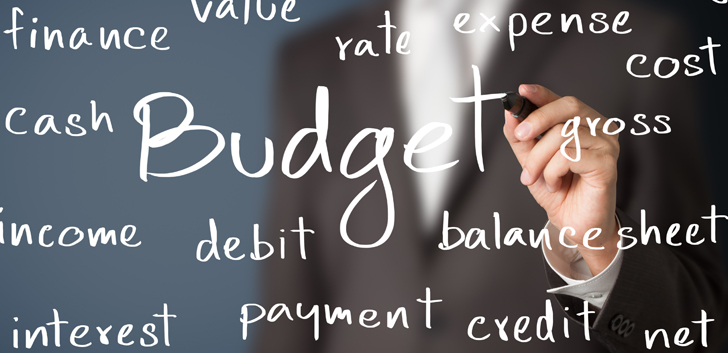4 Ways to Manage Medical Debt
Unfortunately, when you get sick or injured, getting better is often not the only concern. Even if you have health insurance, hefty medical bills can hang over your head like an ominous raincloud. Many people feel that they have no choice but to ignore the bills or eventually file for bankruptcy. However, these are not the only options. There are many ways you can make paying your medical bills more manageable.
1. Check the bills
Often people are so shocked over how much they owe when they first open their bills that they forget to look at them in detail. However, since medical bills are frequently inflated, looking over them carefully could save you money. Maybe you were billed for a four-day stay in the hospital when you only stayed two or charged twice for the same medication. If you see that you were billed in error, contact the medical provider to have the charge removed.
If you have health insurance, it is also a good idea to make sure your insurance company paid for everything covered in your plan. If an insurance company denies a claim, the medical provider will just bill you, even if the treatment is covered under your plan. How easy is it to get an insurance company to pay a denied claim? If it was merely a clerical error, it should be simple. If you are dealing with a stereotypical penny-pinching insurance company trying to wiggle out of a commitment, it could be harder—but not impossible. Most insurance companies allow you to appeal decisions, and if you submit evidence to support why the treatment should be covered, like a letter from your doctor, you may be able to have the denial overturned.
2. Ask for a repayment plan
Even after billing errors are corrected, the amount you owe may still seem frighteningly large. However, there is no need to panic if you cannot pay a bill in full. Most medical providers will allow you to make smaller payments until the bill is paid off and, in many cases, won’t even charge interest. Think about how much you can afford to send each month, and let the medical provider know.
If the medical provider does not accept your proposal, should you not send any money? Not necessarily. Few people will actually refuse money, regardless of how small the amount is. That does not mean you are immune from being sued or having the account be sold to a collection agency, but all you can do is send what you can afford to pay. Not paying your mortgage or other important expenses to get more cash for your medical bills is usually not a good idea.
3. Look for assistance
If you have medical bills from a hospital, you are probably well aware of how high hospital bills can be. Luckily, many hospitals get government funds and donations to cover the bills for patients who cannot pay them themselves. (Other types of medical providers typically do not get such funds but may give you a discount if you describe your hardship.) Talk to your hospital’s billing department or financial counselor about its programs. Remember to find out what the application procedure and qualifications are; often assistance programs are restricted to people who owe above a certain amount, have income below a certain limit, and/or have no medical insurance. Even if you ultimately do not qualify, it does not hurt to ask.
Hospitals are not the only places where you can get financial assistance with your medical debt. Many nonprofits provide the same service. Like with hospitals, nonprofit programs are often restricted to limited income and/or uninsured individuals. To find out what programs are available in your area, contact your local United Way or dial 211 (an information referral service available in most communities). You may also be able to get information from relevant disease support groups.
4. Create a plan for the future
While your current concern may be the bills you need to pay now, chances are, you will have more medical bills to pay in the future. Getting sick is just a part of life. However, if you start saving today, it will be easier to pay whatever bills come your way tomorrow. While you can put your savings in a savings account, you may also want to make use of one of the tax-advantaged accounts available for medical expenses.
If your employer offers it, one option is to set up a flexible spending account. At the beginning of the enrollment period (which if often, but not always, January 1), you tell you employer how much you want withheld from each paycheck and sent to your account. You typically must pay for the costs out of pocket first and then get reimbursed after submitting a claim form. While the money sent to a flexible spending account is not taxed, there is one drawback: you lose any money that is not spent by the end of the year. Thus, you should not contribute more to a flexible spending account than you reasonably expect to spend.
Another option is a health savings account. Like with a flexible spending account, the money contributed to a health savings account is not taxed. However, you do not lose the money that is left over in the account at the end of the year. So, why would anyone choose a flexible spending account over a health savings account? Health savings accounts are not available to everyone. In order to qualify, you must be enrolled in a high-deductible health plan (a plan with higher deductibles and lower premiums than traditional plans). If you have a traditional plan, you are out of luck.
Medical bills can linger long after an injury or illness has been treated. While the amounts owed can seem unbelievably large, remember, there are many things you can do ease the pain of bill paying.
6 Ways to Maintain and Save
When we’re looking to save money, the first thing most of us do is scrutinize our every purchase to see where we can squeeze out unnecessary spending. After all, a nip and a tuck here and there can add up to a bundle of savings over time! What many forget, though, is the cost savings that can result from proper maintenance of the things we already own – especially the really high-ticket items, like a home and car, which can be costly to repair and even more expensive to replace.
R. L. Polk reports the average person holds on to a new vehicle for just under six years. That’s longer than it was before the Great Recession, but with the average new car price topping $33,000, it makes good budget sense to find ways to extend the ownership period as long as possible. Just think of the boost it would be to your retirement savings if you bought just one fewer car in your lifetime, and instead directed that cash to an IRA or 401k account!
Here are some simple things you can do to keep your car and other stuff in good shape for the long haul.
- Get Regular Oil Changes
Be sure to read your vehicle’s owner’s manual to find out how often oil changes and other preventive maintenance is recommended. Nobody knows more than the manufacturer about what your car needs to continue running properly. Plus, not following the manufacturer’s recommended maintenance schedule could affect your warranty. - Check Tires Regularly
A flat tire’s not just inconvenient and expensive to replace. If not fixed promptly, a flat tire can lead to costly wheel damage. In addition to checking tire pressure monthly, have tires rotated, balanced and alignment checked regularly. Oftentimes, this regular maintenance is included in the warranty for new sets of tires. - Following Cleaning Instructions
If the tag says “dry clean only” believe it! Professional cleaning can add up, so you may be tempted to try laundering at home, but it’s a false economy if it means you ruin an expensive item of clothing. Instead, look at care instructions before you buy and decide then whether or not it’s a smart purchase. - Rotate Your Mattress
Some super-premium beds have different maintenance instructions, but if you have a standard mattress and box springs set-up, you’ll get longer life out of it by rotating it at least twice a year. If you notice sagging sooner, go with a three-month rotation schedule. - Replace AC Filters Regularly
A home’s air conditioning system is one of the most expensive items to replace if it goes bad. Twice-yearly maintenance is a prudent investment, and replacing filters regularly is really important since clogged filters can cause the system to burn-out prematurely. - Maintain Exterior Paint
Shabby and peeling paint doesn’t just make the outside of a home look unkempt. A proper paint job protects surfaces from the sun and weather, and helps ensure that cracks are repaired, preventing leaks and helping to keep destructive pests like termites at bay.
Buying Vs. Leasing a Car

There are big differences between buying and leasing. Typically, if you were to purchase a new car, you would make a down payment and finance the remaining cost. At the end of the term, the car would be yours. Leasing is essentially renting, with your payment going towards the car’s depreciation. If the lease includes a purchase option, you may buy it at the end of a specific time period.
So which is better? That depends on your individual situation and needs. You will have to decide for yourself by analyzing the advantages and disadvantages of each:
Leasing Advantages
There are short-term cost advantages to leasing. The monthly payments on a leased car are usually far less than on a loan – even for a luxury model. The down payment usually works out to be less than what you would pay for a bought car as well. Because the typical lease is for three years, most repairs are covered by factory warranty. Sales tax is cheaper too, as you only pay it on the financed portion.
An attractive feature of leasing is the ability to drive a new car every few years. You never have to go through the hassle of selling it; you just turn it in at the end of the term.
Leasing Disadvantages
While the payments are often reasonable, you never gain equity in the car. If you were to buy it at the end of your contract, it would cost you a lot more than if you had just bought it in the first place.
Leases are restrictive. If you exceed the yearly mileage limit you can be assessed an extra charge. You must take good care of the car as well, as any nicks or dings can be considered “wear and tear” and could cost you.
Comparing lease offers can be very confusing, making it hard to know if you got a good deal. And you will find it difficult to get out of your lease early if you want to – a problem if your driving needs or financial circumstances change.
Buying Advantages
When you buy a car, it’s yours. You can customize it and drive it as hard and far as you want, penalty-free. Rather than having infinite payments, buying means you will eventually pay the car off. Once paid off, if you want to sell it you can do so at any time, as Erik Fortier you are not locked into a contract.
Buying Disadvantages
Down payments on bought cars can be substantial. Monthly payments are usually higher than a leased car, and once your warranty expires, you will be responsible for the maintenance costs. When you want to sell it (or trade it in) you will have to go through the hassle of doing so. And, as an investment, new cars depreciate rather than appreciate.
8 Amazing Ways to Avoid Binge-Shopping

It would great if we all made only rational, well-analyzed spending decisions. But none of us are robots. We’ve all made emotional buys at one point or another. Think back on things you bought because you had a rough day at work. Or maybe it was an argument that got you agitated. No matter the cause, purchases made on feelings instead of frugality can be rough on your bottom line. Here are a few ways to soothe yourself without draining your funds
1. Create “me” time
A In a lot of cases overspending happens because it gives you a sense of control over your surroundings. Instead of trying to grab control with money, take control of your time and your surroundings. Whether that means gifting yourself with a nice hot bath or time to work on that tinkering project in the garage, commit to unwinding on your own terms.
2. Connect with a loved one
Loneliness is another emotion that can turn you into a frenzied consumer. A call to a relative you haven’t spoken to in a while or even a spontaneous get-together with a friend can remind you of the wonderful bonds in your life.
3. Volunteer
It may sound strange, but in many cases the best way to help yourself is to work at making someone else’s life better.
4. Exercise
Scientists believe that for certain people splurge shopping releases the same amount of endorphins in the brain as skydiving. So if you are one of those people who gets a real charge out of filling a shopping cart, consider alternatives like going to the gym, walking or riding a bike to get your endorphin rush (if the plane and parachute are not available).
5. Enjoy nature
One of the best ways to get away from your problems is to, well…get away from them! Leave your connectivity behind and get back in touch with a favorite out-of-the-way spot.
6. Read
A little healthy escapism is always good for taking your mind off your day-to-day worries. Whereas passive media like television usually serves more as just a casual distraction, diving into a good book forces you to actively engage in the story.
7. Play
Be it with children or a pet, having some silly fun can shed a lot of stored up tension you might otherwise look to purge with shopping.
8. De-clutter
Because coming home to a place full of stuff can add to your stress level, give yourself a present and a future of increased serenity by hunting for items that can be donated or sold online or at a garage sale.
What is the 50/30/20 Rule?
The 50/30/20 Rule is the simplest way to create a budget. It helps you keep your spending aligned with your savings goals. This very convenient, especially if this is the first time you try to organize your finances. Once you know how to achieve a balanced budget, you can further customize this rule around your unique expenses and goals.
50% of Your Income Goes to Essentials
Start by setting 50% of your income to pay essential items such as rent, utilities, car transportation and housing. This might be a little high in the beginning but once you get the hang of it you will be able to customize your budget to your needs. For instance, some people live in high-rent areas, yet can walk to work, while others enjoy much lower housing costs, but transportation is far more expensive.
30% of Your Income Goes to Your Lifestyle
Your lifestyle is important and although you may need to sacrifice some luxuries, you need to splurge once in a while. Therefore, 30% of your income goes to personal expenses like travel, dining out, cable, and even expensive coffee. If you travel extensively or work on-the-go, your cell phone plan is probably more of a necessity more than a luxury. It is up to you to decide which items are consider personal and which you should cut-off.
20% of Your Income Goes to Savings
The last step is to designate 20% of your income to savings. This is for your future, for everything unexpected that may come your way. This is the category you should think about after your essentials and before feeding your lifestyle expenses. It is your “get ahead” section and you must give it importance.
You don’t need to make a lot of money to budget properly. The 50/30/20 rule is only the beginning, you will customized this rule when you become an expert at budgeting.
How Can You Reduce Your Home Ownership Cost?

Owning a home is rewarding but it can also be costly at times. You have to be able to keep up with air conditioner repairs, appliances breaking down, and pipes that can sometimes burst. The Bureau of Labor Statistic reported that an average homeowner paid $4,808 in mortgage principal and interest in 2013.
The good news is that home ownership costs aren’t fixed and we have a few tips that might help you.
- Buy a Smart ThermostatIn Florida AC is not a luxury, is a necessity. Sometimes it gets so warm outside it is easy to feel discomfort when all you think of is cooling off. In order to help you reduce your AC cost, try a smart thermostat. It can adjust to your household routines, temperature preferences, external weather conditions, and can even track your location.
Why is this useful? With a thermostat this sophisticated you can divide your days into blocks and set desire temperatures for each. For example, you can adjust your settings to a higher temperature while you’re at work and lower them when you return from work automatically. A smart thermostat can trim cooling cost by 15%.
- Switch to low flow fixturesAlthough water is not as expensive as electricity, saving water can save you money. Low-flow faucets reduce tap water usage by up to 30%. Low-flow toilets can save a family of four around $110 a year depending on home size.
- Insulate Hot Water PipesAccording to the Department of Energy, insulating your hot water pipes can reduce your electricity or gas bill by $12 annually. Insulating your hot water pipes is inexpensive—especially if you have duct tape at home.
- Unplug Idle ElectronicsEvery time you leave your TV, cable boxes, computers and other small electronics plugged you drain power and drive up your electricity bill. There are devices that can help you power off devices without having to unplug them. Such as the Bits Energy Smart Strip, this can cost up to $40 and help you reduce your light bill on a monthly basis.
These tips will not save you thousands of dollars in home ownership cost. However, it can save you a few hundreds and every little bit helps.
How Can You Pay Off Your High Debt?

High debt can make you feel stressed, worried, and a little discouraged. Just remember, where there is a will, there is a way to pay. One of our goals as a credit union is to help you become financially stable. Take a deep breath, create a timeline and think how you can reduce your spending.
Then use some of the following tips as a guidance to help you pay off your high debt.
- Get rid of high rate credit cards first
What does this mean?
Your credit card interest rate vary between financial institutions. Allowing your spending to increase unconsciously. For example let’s pretend you spend $450 in credit card A with a 29.99% interest rate; and you spend $475 with a 12% interest rate in credit card B. In time, the $450 spent in credit card A may become more expensive due to its higher interest rate. You must avoid falling into this trick.
First, go over all your credit card statements and create a list starting with your highest interest cards and ending with your lowest. By increasing the payment on your highest interest cards you are saving money and avoiding high interest charges.
TIP: Remember to continue paying the minimum amount due on the rest of your credit cards.
- Take advantage of Balance Transfer Promotions.
If you have high interest rates on another credit cards think about moving your debt to your BrightStar Credit Card—especially during our Balance Transfer Promotion period. Keep in mind you must be strict with your payments in order to take advantage of the promotional rate before it expires.
- Stop spending so much on your credit cards.
If you’re trying to pay off your high debt, credit cards are NOT your best friend. Remove all credit cards from your wallet, and start budgeting your expenses with cash. Don’t worry, this change is only temporary, only while you get more financially stable.
- Put work bonuses, or other incentives toward debt.
We get it! Taking that work bonus and using it on a nice vacation is tempting. However, sometimes we need to put temptation aside and start thinking of our financial future. If you receive a bonus for a good sale, holiday, or other use it to pay off your debt. Your wallet will thank you later.
- Sell unwanted items online.
A good way to make some extra cash is to clean your house from unwanted items. Sell those old presents collecting dust and start fattening up your wallet. After all, one man’s trash is another’s treasure.
High debt should not affect your well-being. Go on, change your habits, make some smart choices, and reward yourself in the future.
You can do it!
How to Create a Simple Budget?

To spend wisely is to live more comfortably. Yes, we get it, you hate the word “budget” it is scary and at the same time overwhelming . The thought of quitting some of your spending can seem unimaginable. But, fear not, budgeting allows you to see where your money goes. Leaving you with the option to treat yourself once in while without feeling overwhelmed by debt.
How should you start?
- Calculate your income and your expenses
The first step is simple. Write down how much you make along with some prioritized spending categories. Include your rent or mortgage, utilities, food, automobile expenses, and insurance.TIP: Make sure you budget for fun. You should not spend $200 every Saturday night, but you can leave $150 aside to have some fun during the week. This way you can continue to enjoy your fancy coffee and your brunch with friends. - Set realistic goals for your budget: If you want to go on a trip to visit family during the holidays, do not wait to start saving. Create a separate Wish Account to prepare you for your vacation. This will allow you to have some self control. It will stop you from spending money on petty items and you might be able to enjoy your vacation without worrying about the bills that await home.
- Track your progress: Creating a budget is only helpful if you can commit to it. Tracking your monthly, weekly, and daily spending will allow you evaluate and reflect on your progress. Remember your spending may fluctuate according to the month and that’s Okay. Just be diligent and discipline the majority of your time.
There is no science behind budgeting, the trick is to spend less than what you make. Come on members! Have discipline, be conscious of your spending, and save money.
Good Luck!








